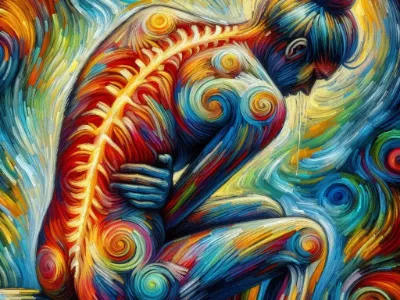 acupuncture for sciatica
acupuncture for sciaticaACUPUNCTURE_SCIATICA
Sciatica, An Inevitable Modern Lifestyle Disease
Acupuncture Repairs Sciatica
If you are like most American adults, you spend at least 6 hours sitting each day and will likely develop sciatica and suffer from back pain.
What is Sciatica?
Sciatica refers to pain that radiates along the path of the sciatic nerve, which extends from the lower back through the hips, buttocks, and down each leg. It is typically caused by irritation, inflammation, or compression of the sciatic nerve.
Primary Causes of Sciatica
Several underlying conditions can contribute to sciatica, including:
Herniated or Bulging Spinal Discs: Occurs when the soft inner material of a spinal disc protrudes through its outer layer, directly pressing on nerve roots and causing intense pain and inflammation.
Lumbar Spinal Stenosis:
A condition where the spinal canal narrows, compressing the spinal cord and nerve roots, leading to pain, numbness, and reduced mobility.
Piriformis Syndrome:
A neuromuscular disorder where the piriformis muscle in the buttocks irritates or compresses the sciatic nerve, causing pain and dysfunction.
Degenerative Disc Disease:
A natural aging process where spinal discs break down, lose flexibility, and can create bone spurs that press on nerve roots.
Spondylolisthesis:
A condition where a vertebra slips forward or backward, causing misalignment and potential nerve compression.
Traumatic Injuries:
Accidents, falls, or sudden impacts that damage the spine or surrounding tissues, leading to nerve irritation or compression.
Tumors or Infections:
Rare but serious conditions that can directly impact the spine or nerve roots, requiring immediate medical attention.
Types of Sciatica
Sciatica can manifest in different forms, including:
Acute Sciatica:
A short-term condition typically lasting 4-8 weeks, often resulting from sudden injury or strain, and usually responding well to conservative treatment methods.
Chronic Sciatica:
Persistent pain lasting longer than 8 weeks, indicating a more complex underlying condition that may require comprehensive medical intervention and long-term management strategies.
Alternating Sciatica:
Pain affecting both legs alternately.
Bilateral Sciatica:
A rare and more severe form affecting both legs simultaneously, often suggesting a more serious spinal or neurological issue that demands thorough medical investigation.
Saddle Sciatica:
Specifically impacts the area that would contact a bicycle saddle, typically indicating compression or irritation of nerves in the lower spine and pelvic region.
Symptoms of Sciatica
The symptoms vary in intensity and location, depending on the severity of nerve compression. Common signs include:
Sharp, burning pain in the lower back that radiates down one or both legs
Numbness, tingling, or weakness in the affected legs or feet, indicating potential nerve interference
Burning or electric shock sensations
Muscle weakness that may affect walking or standing, difficulty moving or controlling the affected leg
Worsening pain when sitting, bending, or standing for long periods
Shooting pain triggered by coughing, sneezing, or sudden movements
Potential loss of bladder or bowel control in severe cases (requires immediate medical attention)
Consequences of Untreated Sciatica
Ignoring sciatica can lead to complications, including:
Permanent Nerve Damage:
Prolonged nerve compression can lead to irreversible neurological damage and chronic pain.
Chronic Pain Syndrome:
Persistent pain that becomes increasingly difficult to manage and impacts mental health.
Loss of Mobility:
Progressive reduction in physical capabilities and independence.
Muscle Atrophy:
Gradual weakening and shrinking of muscles due to reduced use and nerve dysfunction.
Increased Risk of Falls:
Due to leg weakness.
Depression and Anxiety:
Chronic pain's psychological toll can significantly impact mental well-being.
Reduced Quality of Life:
Limitations in work, social interactions, and personal activities.
Conventional Treatment Methods and Limitations
Traditional treatments for sciatica aim to reduce pain and inflammation, including:
Medications:
NSAIDs, muscle relaxants, and pain relievers provide temporary relief but do not address the root cause.
Physical Therapy:
Stretching and strengthening exercises help improve mobility but may not work for all cases.
Corticosteroid Injections:
Provide short-term relief but have potential side effects with repeated use.
Surgery:
A last resort for severe cases involving nerve damage, with associated risks and recovery time.
While these treatments can be effective, they often focus on symptom management rather than addressing the underlying cause of sciatic nerve irritation.
Major limitations of conventional treatments include:
Potential side effects from long-term medication
Temporary pain relief without addressing root causes
Risk of surgical complications
High treatment costs
Potential dependency on pain medications
Limited effectiveness for some patients
How Acupuncture Can Address Sciatica
Acupuncture, a key component of Traditional Chinese Medicine (TCM), offers a holistic and drug-free approach to treating sciatica by:
Reducing Inflammation:
Acupuncture stimulates the body's natural anti-inflammatory response, alleviating pressure on the sciatic nerve.
Releasing Endorphins:
The treatment promotes the release of natural painkillers, reducing discomfort.
Improving Blood Circulation:
Enhanced circulation helps nourish tissues and facilitate healing.
Relaxing Muscles:
Acupuncture reduces muscle tension, preventing nerve compression caused by tight muscles and improving overall body balance.
Restoring Energy Flow (Qi):
According to TCM, acupuncture balances energy pathways to promote overall well-being and reduce pain.
Stimulating the Body's Natural Healing Mechanisms
Benefits of Acupuncture:
Non-invasive treatment with minimal risk
Minimal side effects compared to pharmaceutical interventions
Addresses underlying energy imbalances
Complements conventional treatments effectively
Promotes overall wellness and body harmony
Integrative Approach
Sciatica can significantly impact quality of life, but effective treatments are available. While conventional methods provide temporary relief, acupuncture offers a natural, holistic approach to address both symptoms and underlying causes.
If you're struggling with sciatic pain, consider acupuncture as a safe and effective alternative to restore mobility and improve well-being.
If you found this article helpful, share it with others who may benefit. For personalized acupuncture treatment, consult a licensed practitioner to explore the best approach for your condition.
Visit Yi Acu Clinic for your customized sciatica treatment plan today.
 Yi Acu Clinic
Yi Acu Clinic